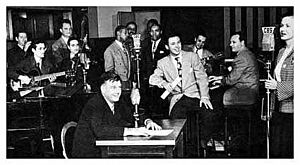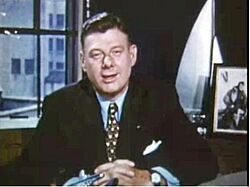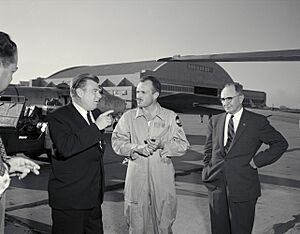Arthur Godfrey facts for kids
Arthur Morton Godfrey (born August 31, 1903 – died March 16, 1983) was a famous American radio and television host. People sometimes called him The Old Redhead. In the early to mid-1950s, Godfrey was extremely popular. He was on radio and TV almost every day, sometimes hosting many shows for CBS. His programs included Arthur Godfrey Time, Arthur Godfrey's Talent Scouts, and Arthur Godfrey and His Friends.
However, his popularity changed after a famous event in 1953. He fired a cast member, Julius La Rosa, live on the air. This made many people upset and changed how they saw Godfrey. He was known for being down-to-earth, but this event made him seem less friendly. Over the next two years, he fired many more people. The media and public criticized him a lot for this. Godfrey was a very competitive person. Some employees were fired just for talking to people he saw as rivals, like Ed Sullivan. By the late 1950s, he hosted fewer shows. His daily CBS radio show ended in 1972.
Godfrey was also well-known for advertising products. He worked closely with companies like Chesterfield cigarettes and Lipton Tea. He promoted Chesterfield cigarettes for many years. He even created the slogan "Buy 'em by the carton." But he stopped working with them after he quit smoking. Five years later, in 1959, he was diagnosed with lung cancer. After that, he became a strong supporter of the anti-tobacco movement.
Contents
Early Life and Family
Arthur Godfrey was born in Manhattan in 1903. His mother, Kathryn Morton Godfrey, came from a wealthy family. His father, Arthur Hanbury Godfrey, was an Englishman and a sportswriter. He was an expert on certain types of horses. But when cars became popular, his family lost a lot of money.
By 1915, when Arthur was 12, his family moved to Hasbrouck Heights, New Jersey. Arthur was the oldest of five children. He tried to help his family by working before and after school. At 14, he left home to help ease the financial burden. At 15, he worked as a typist at Camp Merritt, New Jersey. Two years later, he joined the Navy, even though he was too young.
Godfrey's Parents
Arthur's father was a "free thinker" for his time. He wanted his children to learn about all religions. He was friends with the Vanderbilt family, but also enjoyed talking to everyday people. His father strongly disliked the Ku Klux Klan. He once argued with a man on a ferry about the Klan, calling them "Blasted, bigoted fools!"
Godfrey's mother, Kathryn, was a talented artist and composer. She put her dreams aside to care for her family after her husband died. She played piano for silent films and made crafts to earn money. She even sold her long hair to help the family. The family always kept their piano. She believed some of her children would become successful in entertainment. Later in life, some of her music was performed by orchestras in Canada. In 1958, she appeared on Groucho Marx's show You Bet Your Life and was a big hit.
Early Career and Radio Training
Godfrey served in the United States Navy from 1920 to 1924. He worked as a radio operator on naval destroyers. He then returned home to help his family after his father's death. He got more radio training in the Coast Guard from 1927 to 1930. He passed a tough test to get into the Radio Materiel School. He graduated in 1929. While in the Coast Guard in Baltimore, he appeared in a local talent show. This led to his own small weekly radio program.
Radio Career

After leaving the Coast Guard, Godfrey became a radio announcer. He worked for station WFBR in Baltimore. Then he moved to Washington, D.C., and joined NBC's WRC in 1930. He stayed there until 1934.
In 1931, Godfrey was in a bad car accident. While recovering, he listened to the radio a lot. He realized that announcers sounded too formal. They spoke as if giving a speech, not talking to one person. Godfrey decided he would use a relaxed, informal style. He wanted to sound like he was talking to a friend. He also used this style for his own commercials. This made him a local star. He would even joke about the sponsors, which was risky. But his jokes made sales go up, so sponsors were happy.
Becoming a National Voice
Godfrey also sang and played the ukulele. In 1934, he became a freelance entertainer. He hosted a daily show called Sundial on CBS station WJSV in Washington. He was the morning disc jockey, playing music, reading news, and interviewing guests. He loved to sing and would often sing during his show. In 1937, he hosted Professor Quiz, one of radio's first successful quiz shows.
Godfrey wanted to stay connected with the Navy. His hip injuries from the accident kept him from active duty. But he knew President Franklin D. Roosevelt, who listened to his show. Through Roosevelt, he became a reserve officer in the U.S. Naval Reserve before World War II.
Godfrey became nationally famous in April 1945. As CBS's morning radio host in Washington, he reported live on President Roosevelt's funeral procession. The entire CBS network broadcast his report. Unlike other reporters, Godfrey's tone was very emotional and personal. When he saw President Harry S. Truman's car, he said, "God bless him, President Truman," and cried. This emotional moment touched the whole nation.
Arthur Godfrey Time
CBS then gave Arthur Godfrey his own morning show across the country. Arthur Godfrey Time was a Monday-Friday show. It featured his talks, interviews with stars, and music from his band and singers. Godfrey's talks were usually unscripted. Arthur Godfrey Time stayed on CBS Radio until 1972.
Two of his talks, "What is a Boy?" and "What is a Girl?", were very popular. He often replayed them. With soft music, these talks described the loving traits of children. They were so popular that "What is a Boy?" was released as a record in 1951. It reached the top of the Billboard charts.
Godfrey was also known for starting impromptu jam sessions with his band. He would sing with his ukulele, and the band would join in. He encouraged solos from band members. This showed his love for spontaneous performances. He learned to play the baritone ukulele and developed a jazzy style.
In 1947, Godfrey had a surprise hit song called "Too Fat Polka (She's Too Fat For Me)". It reached number two in the US charts. He generally disliked most of his novelty songs, but "Too Fat Polka" sold over a million copies.
Arthur Godfrey's Talent Scouts
Godfrey's morning show was joined by a prime-time variety show, Arthur Godfrey's Talent Scouts. This show helped new, young performers. It was similar to CBS's Original Amateur Hour. Some performers were recommended by friends or colleagues. Two acts from a 1948 show, Wally Cox and the Chordettes, became very popular. Godfrey especially liked the Chordettes and made them part of his "family" of performers.
Famous performers who appeared on Talent Scouts included Tony Bennett, Patsy Cline, and Pat Boone. However, some notable acts were rejected, like Buddy Holly and Elvis Presley. Presley auditioned in April 1955 but was not chosen.
Godfrey was also a passionate amateur radio operator. His call sign was K4LIB. He was inducted into the National Association of Broadcasters Hall of Fame.
Theatre and Television
In 1946, Arthur appeared in a Broadway show called Three to Make Ready. He gave talks and acted as a host. In 1965, he was in the play Never Too Late on Broadway.
In 1948, Arthur Godfrey's Talent Scouts began to be shown on both radio and television. By 1952, Arthur Godfrey Time also became a radio and TV show. Godfrey's skill at selling products brought him many loyal sponsors. These included Lipton Tea and Chesterfield cigarettes. By 1959, his TV shows brought in an estimated $150 million in advertising, which was very high for the industry.
Godfrey often made his commercials more interesting by joking about the sponsors or the advertising agencies. He would sometimes even throw away the scripts on camera. Surprisingly, his playful attitude often made sales go up. His popularity and ability to sell products brought a lot of money to CBS.
In 1949, Arthur Godfrey and His Friends, a weekly variety show, started on CBS-TV. Fans loved Godfrey because they felt he was "one of them," like a friendly neighbor. He insisted he would only promote products he believed in. This made his audience trust him deeply. When he quit smoking after his 1953 hip surgery, he started speaking out against smoking on air. This upset his longtime sponsor, Chesterfield, who then stopped sponsoring his show in 1954. Godfrey didn't mind, knowing other sponsors would take their place.
The "Little Godfreys"
Godfrey began to feature a small group of regular performers. They became known as the "Little Godfreys." Many of these artists were not well-known before. They gained huge national exposure through Godfrey's shows. Some were winners from Talent Scouts. These included Hawaiian singer Haleloke and singer Julius La Rosa. La Rosa was in the Navy when Godfrey discovered him. He joined the cast in 1951 and became very popular.
Godfrey preferred his performers not to have personal managers or agents. He wanted his own staff to handle their careers. This gave him a lot of control over their work and earnings. In 1953, La Rosa hired an agent. Godfrey was so angry that he fired him live on the air. This event caused a lot of public criticism and hurt Godfrey's image.
Godfrey was one of the busiest people in entertainment. He often hosted several radio and TV shows at the same time. He also made commercial recordings for Columbia Records with the "Little Godfreys." These included "Too Fat Polka" and "The Thing".
In 1953, Godfrey had pioneering hip replacement surgery due to an injury from his 1931 car crash. The operation was successful. He returned to his show, which delighted his audience. During his recovery, CBS allowed him to broadcast live from his farm in Virginia.
Godfrey's popularity was noticed by President Dwight Eisenhower. Eisenhower asked him to record public service announcements for TV in case of a nuclear war. It was thought that Godfrey's friendly voice would reassure viewers.
Aviation and Environmental Advocacy
Godfrey learned to fly in 1929. He started with gliders and then learned to fly airplanes. His hip injury from the 1931 car crash kept him from flying in active duty during World War II. He served as a reserve officer in the United States Navy in a public relations role.
Godfrey used his fame to support a strong anti-Communist stance. He also pushed for stronger air power during the Cold War. He also supported civil rights and promoted Hawaii and Miami Beach, Florida as vacation spots for middle-class families.
In 1953, he made a TV movie where he flew an Eastern Air Lines Lockheed Constellation airliner to Miami. This showed how safe airline travel had become. As a reserve officer, he convinced the Navy to qualify him as a Naval Aviator. He later joined the Air Force Reserve. He was known for flying many types of military aircraft.
His constant promotion of Eastern Air Lines earned him the thanks of his friend Eddie Rickenbacker, the airline's president. Rickenbacker even gave Godfrey a retired Douglas DC-3 plane. Godfrey used it to fly from his farm in Virginia to the studios in New York City.
Aviation Incidents
In January 1954, Godfrey flew his DC-3 very low over the control tower of Teterboro Airport. His pilot's license was suspended for six months. He said windy conditions made him turn quickly after takeoff. But he was actually upset with the tower for not giving him the runway he wanted. He later recorded a funny song about the incident called "Teterboro Tower."
Leesburg Airport
Godfrey owned the original Leesburg airport, which he called "The Old Cow Pasture." It was very close to town. Local residents often heard rattling windows when he flew in or out.
In 1960, Godfrey suggested building a new airport. He sold the old field and donated money to a local group. Since Godfrey funded most of the new airport, it is now called Leesburg Executive Airport at Godfrey Field. He also flew smaller planes like a North American/Ryan Navion and a Beech Baron. In 1964, he helped start Executive Jet Aviation Corporation.
Later Life and Legacy
In 1959, Godfrey had chest pains. Doctors found cancer in one lung that had spread. One lung was removed. Despite the serious diagnosis, he recovered after radiation treatments. He returned to the air on a TV special. He then continued his daily morning show on radio only. He featured guest stars and a live band. Godfrey also became a strong advocate for regular medical checkups to detect cancer early. He stressed that his cancer was cured because it was found in time.
His long-time announcer, Tony Marvin, left the show on good terms. The Arthur Godfrey Time radio show was the last daily long-form entertainment program on American network radio. It ended in April 1972, when his contract with CBS expired. By then, Godfrey was a colonel in the United States Air Force Reserve and still an active pilot.
He appeared in films like 4 for Texas (1963) and The Glass Bottom Boat (1966). He also briefly co-hosted Candid Camera in 1960–61. He made various guest appearances, including co-hosting the CBS special 50 Years of Television (1978) with Lucille Ball.
Post-Retirement Activities
After retiring, Godfrey wanted to return to regular TV. He appeared on a song by the rock band Moby Grape. Godfrey's political views were interesting. He admired Franklin Roosevelt but also supported Dwight D. Eisenhower. In his later years, he became a strong voice for the environmental movement. He felt he was like the youth culture that challenged the "establishment."
He even turned down a profitable endorsement deal with Colgate-Palmolive. He learned that their detergent, Axion, contained phosphates, which cause water pollution. He did far fewer commercials after that.
Godfrey loved technology, especially aviation. But he also enjoyed older pursuits like horseback riding and dressage. He performed at horse shows for charity.
He also realized that some technology could harm the environment. On The Dick Cavett Show, Godfrey said the United States needed the supersonic transport (SST) "about as much as we need another bag of those clunkers from the moon." His concern about the SST causing noise pollution helped end interest in it in the U.S.
Godfrey always wanted to stay in the public eye. His presence in media lessened over time. An attempt in 1981 to reunite him with Julius La Rosa for a record album failed. Godfrey initially resisted the idea but agreed to a meeting. At the meeting, Godfrey claimed La Rosa had wanted to leave his contract. When La Rosa started talking about their past disagreement, Godfrey, then in his late seventies, became very angry, and the meeting ended.
The Arthur Godfrey Collection
Towards the end of his life, Godfrey became a big supporter of public broadcasting. He left his large collection of papers and programs to public station WNET/Thirteen in New York. Later, his collection found a permanent home at the Broadcasting Archives at the University of Maryland. This collection includes hundreds of recordings of his TV and radio shows, plus his personal and business records. They cover his rise and fall in the entertainment industry over 50 years.
Death
Emphysema, likely caused by decades of smoking and radiation treatments for his lung cancer, became a problem in the early 1980s. Arthur Godfrey died from this condition on March 16, 1983, at age 79, in Manhattan. He was buried at Union Cemetery in Leesburg, Virginia, near his farm.
Personal Life
Godfrey was married twice. He had one child with his first wife, Catherine. He then married Mary Bourke on February 24, 1938. They were married until their divorce in 1982, a year before he died. They had two children. His granddaughter is Mary Schmidt Amons, who was on The Real Housewives of Washington, D.C..
Awards
- NBAA Meritorious Service to Aviation Award (1950)
- National Association of Broadcasters Hall of Fame (radio)
- National Aviation Hall of Fame (1987)
- Radio Hall of Fame (1988)
- Peabody Award (1971)
- Hollywood Walk of Fame ( Honored with three stars; Radio, TV, Recording)
- Ukulele Hall of Fame (2001)
- In 2002 Godfrey was one of only three people named on both of industry publication Talkers Magazine's 25 greatest radio, and 25 greatest television, talk show hosts of all time lists.
Images for kids







